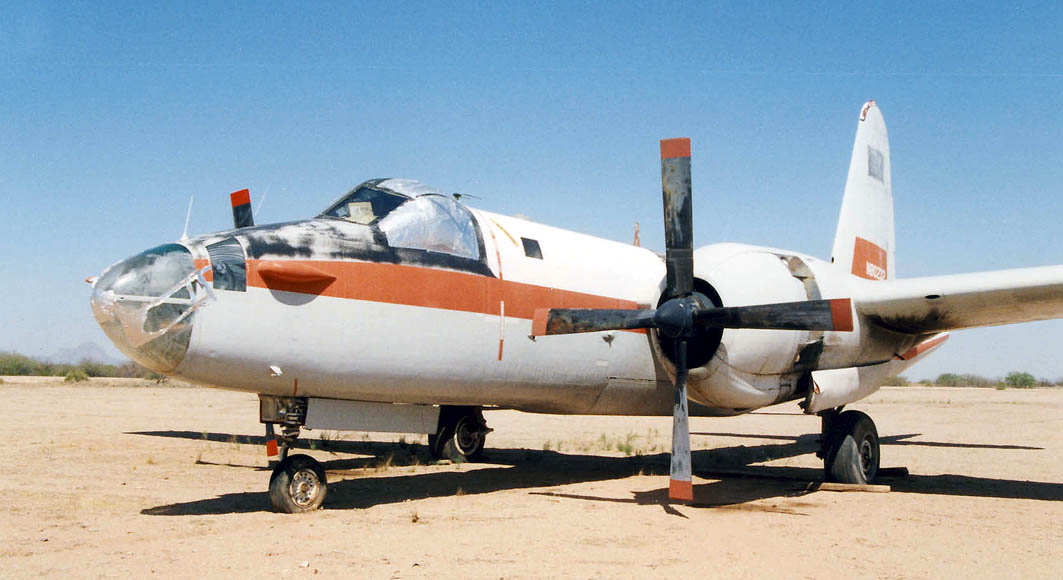Estás usando un navegador obsoleto. No se pueden mostrar estos u otros sitios web correctamente.
Se debe actualizar o usar un navegador alternativo.
Se debe actualizar o usar un navegador alternativo.
Aeronaves Abandonadas
- Tema iniciado soyelmejor
- Fecha de inicio

Un soldado americano observa los restos de un Henschel Hs 129.
Hummm..parecido al Pucara....
Tarkus40
Colaborador
una obra de arte el camuflado.
Un soldado americano observa los restos de un Henschel Hs 129.
Slds
War-torn Warbirds: 30 images of worn out, crashed or just plain lonely Dakotas

The DC-3 did not go unnoticed by one of Douglas’s oldest customers — the U.S. Army.
The military career of the Douglas DC series began in 1936 when the Army Air Corps ordered a pair of DC-2s under the designation C-32. A contract followed for 18 DC-2s in the C-33 freighter configuration and two more as C-34 staff transports. Then, in 1937, the Army ordered a plane built to its own specifications. It was a hybrid design that combined the fuselage of the DC-2 with a DC-3 tail. This was the sole C-38 prototype and it led to 35 production versions called the C-39. The C-39 represented the first serious effort by the Army to establish an airlift capability.
By 1941 the old Air Corps had been transformed into the Army Air Forces, and it selected a modified version of the DC-3 — the C-47 Skytrain — to become its standard transport aircraft. A reinforced fuselage floor and the addition of a large cargo door were the only major modifications. Other changes included the fitting of cargo hooks beneath the centre wing section and the removal of the tail cone to mount a hook for towing gliders.
[iframe style="border: 0px currentColor; vertical-align: bottom;" id="google_ads_iframe_/6766078/WHOL_300x250_inline_0" height="280" marginHeight="0" src="javascript:"[/iframe]
As a supply plane, the C-47 could carry up to 6,000 pounds of cargo. It could also hold a fully assembled jeep or a 37 mm cannon. As a troop transport, it carried 28 soldiers in full combat gear. As a medical airlift plane, it could accommodate 14 stretcher patients and three nurses. Seven basic versions were built, and the aircraft was given at least 22 designations, including the AC-47D gunship, the EC-47 electronic reconnaissance aircraft, the EC-47Q antiaircraft systems evaluation aircraft and the C-53 Skytrooper.
Every branch of the U.S military and all the major allied powers flew it. The U.S. Navy version was the R4D. The British and the Australians designated it the Dakota (a clever acronym composed of the letters DACoTA for Douglas Aircraft Company Transport Aircraft). The aircraft operated from every continent in the world and participated in every major battle. By the end of World War II, more than 10,000 had been built. For all of its official and unofficial names, it came to be known universally as the “Gooney Bird” General Dwight D. Eisenhower, Supreme Commander of Allied Forces in Europe, termed it one of the most vital pieces of military equipment used in winning the war.
C-47s remained in active military service long after the end of World War II. They played a critical role in the 1948 Berlin Airlift and saw action in the Korean and Vietnam wars.
You can read our book review of the Dakota Hunter here
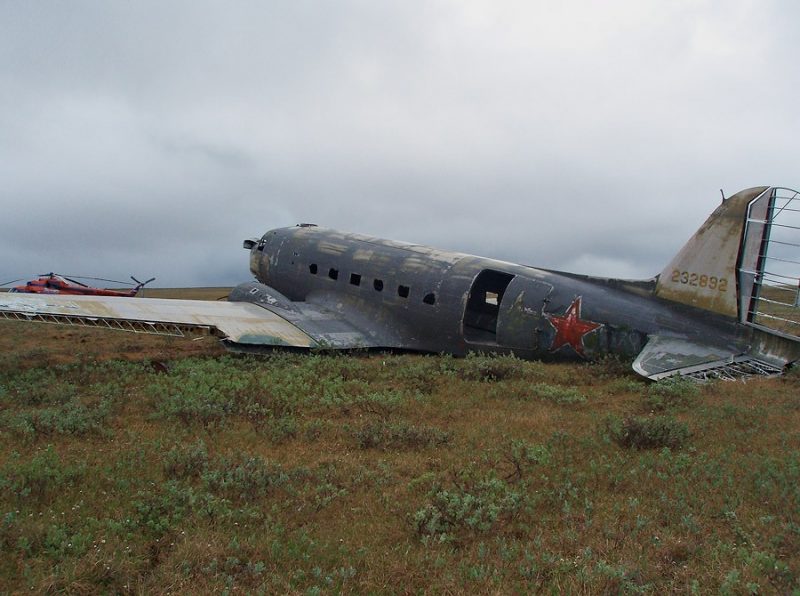

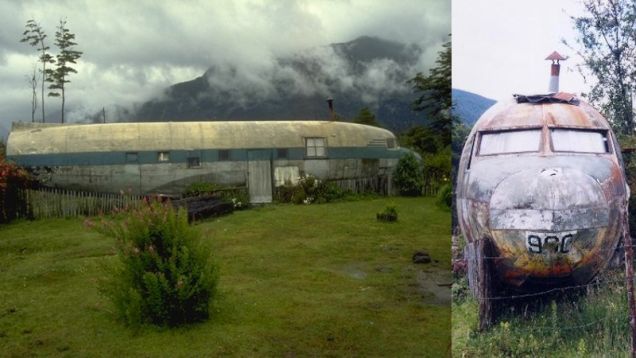
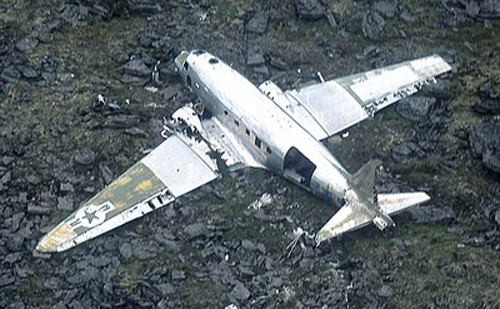




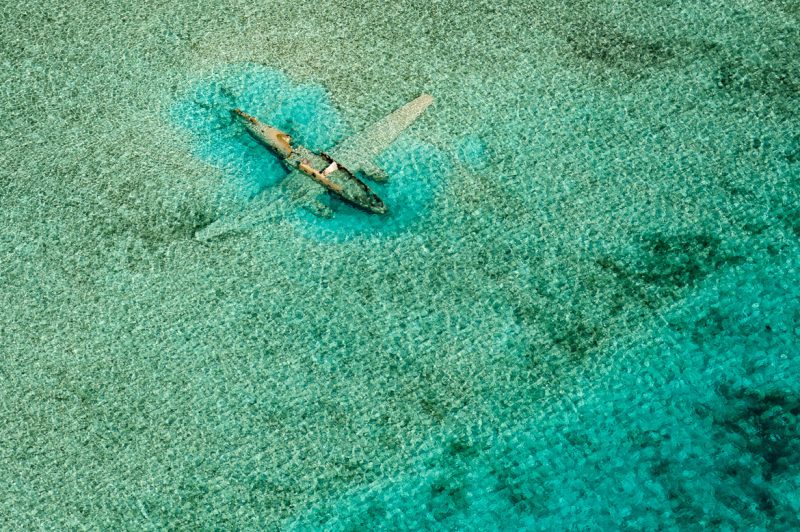

The C-47 was vital to the success of many Allied campaigns, in particular those at Guadalcanal and in the jungles of New Guinea andBurma, where the C-47 (and its naval version, the R4D) made it possible for Allied troops to counter the mobility of the light-traveling Japanese army. Additionally, C-47s were used to airlift supplies to the embattled American forces during the Battle of Bastogne. Possibly its most influential role in military aviation, however, was flying “The Hump” from India into China. The expertise gained flying “The Hump” was later be used in the Berlin Airlift, in which the C-47 played a major role, until the aircraft were replaced by Douglas C-54 Skymasters.

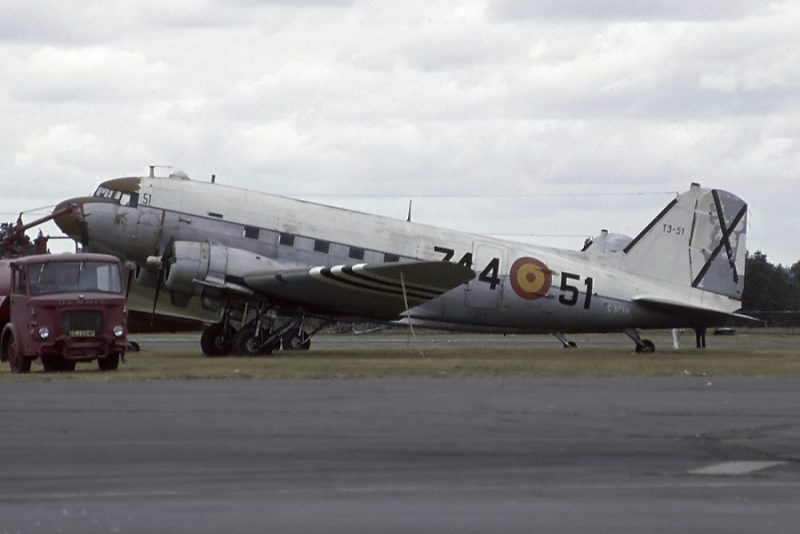

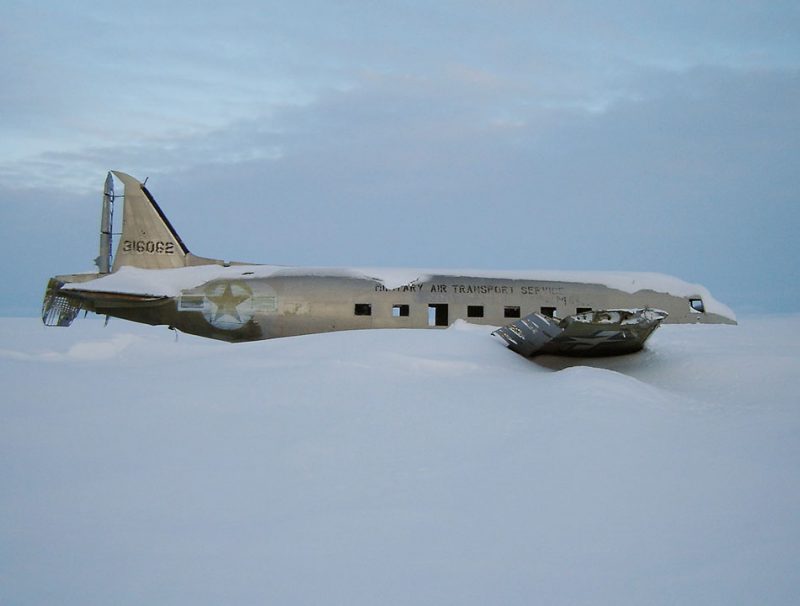
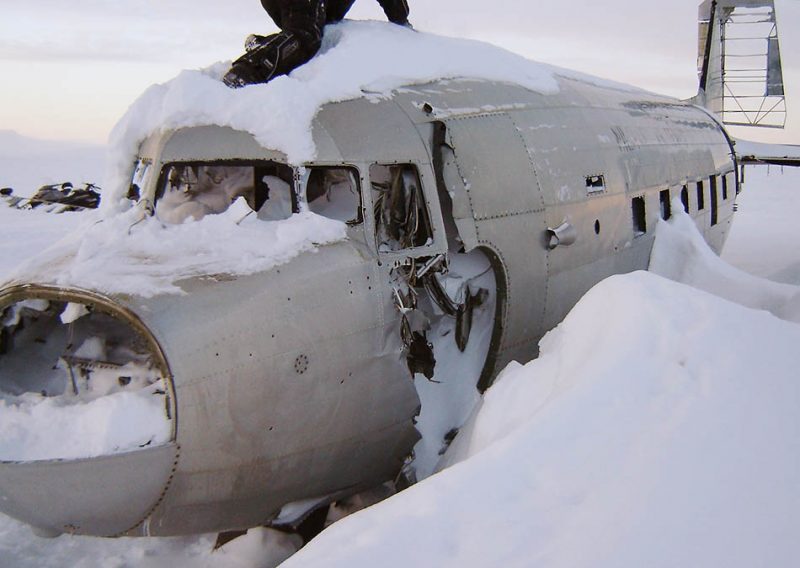

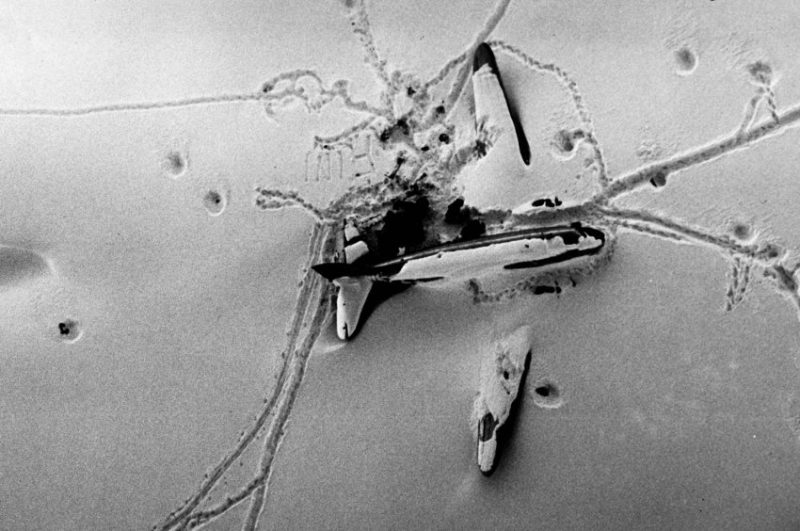
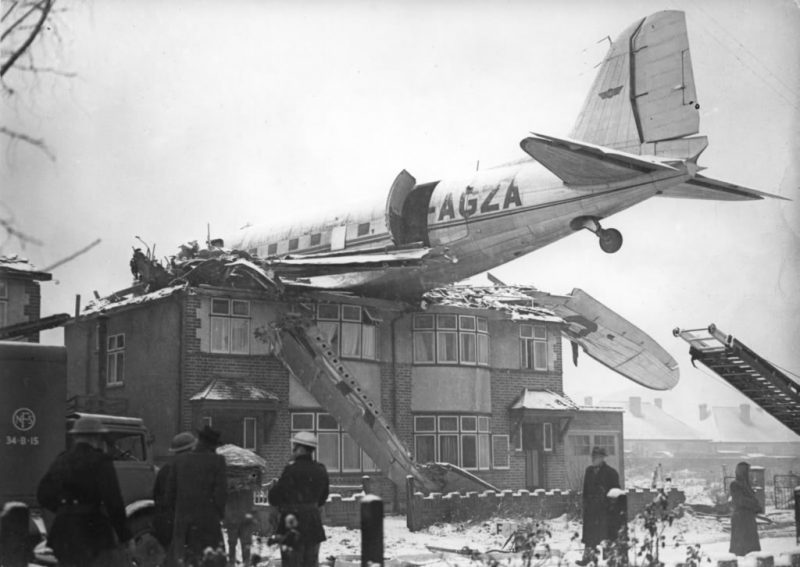
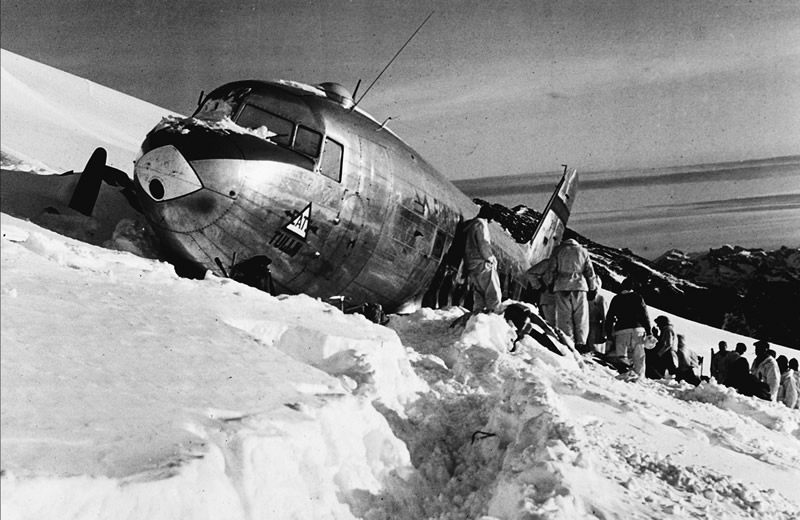

The C-47 was delivered in large numbers to U.S. allies under lend-lease. It was built under license in the Soviet Union, where it was designated the Lisunov Li-2 and remained the backbone of internal air transport well into the 1960s. The C-47 was a pillar of U.S. military airlift during the early stages of the Cold War, figuring large in the 1948 Berlin Airlift and in the Korean War (1950–53). C-47s were used in the Vietnam War as electronic warfare collection aircraft and as AC-47 gunships. Many hundreds remain in civil service today.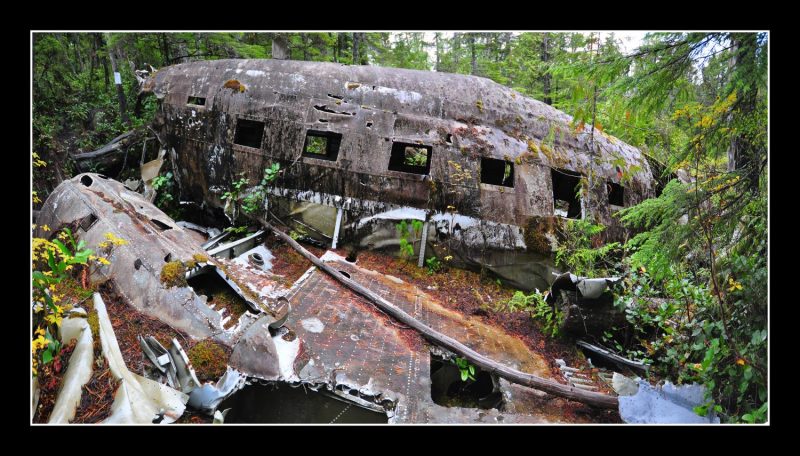
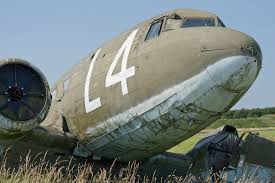
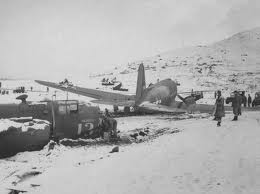




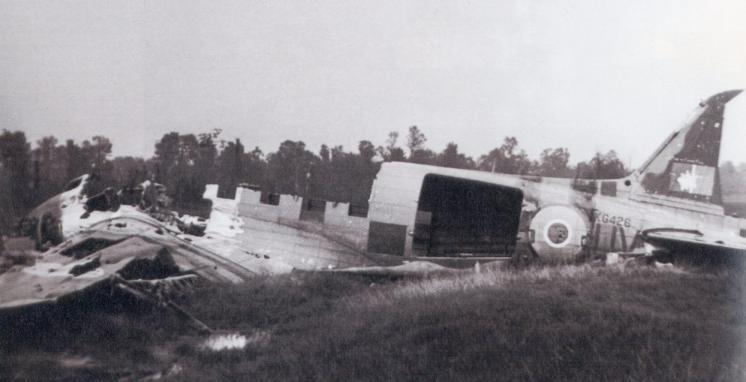

 You can read our book review of the Dakota Hunter here
You can read our book review of the Dakota Hunter here

The DC-3 did not go unnoticed by one of Douglas’s oldest customers — the U.S. Army.
The military career of the Douglas DC series began in 1936 when the Army Air Corps ordered a pair of DC-2s under the designation C-32. A contract followed for 18 DC-2s in the C-33 freighter configuration and two more as C-34 staff transports. Then, in 1937, the Army ordered a plane built to its own specifications. It was a hybrid design that combined the fuselage of the DC-2 with a DC-3 tail. This was the sole C-38 prototype and it led to 35 production versions called the C-39. The C-39 represented the first serious effort by the Army to establish an airlift capability.
By 1941 the old Air Corps had been transformed into the Army Air Forces, and it selected a modified version of the DC-3 — the C-47 Skytrain — to become its standard transport aircraft. A reinforced fuselage floor and the addition of a large cargo door were the only major modifications. Other changes included the fitting of cargo hooks beneath the centre wing section and the removal of the tail cone to mount a hook for towing gliders.
[iframe style="border: 0px currentColor; vertical-align: bottom;" id="google_ads_iframe_/6766078/WHOL_300x250_inline_0" height="280" marginHeight="0" src="javascript:"[/iframe]
As a supply plane, the C-47 could carry up to 6,000 pounds of cargo. It could also hold a fully assembled jeep or a 37 mm cannon. As a troop transport, it carried 28 soldiers in full combat gear. As a medical airlift plane, it could accommodate 14 stretcher patients and three nurses. Seven basic versions were built, and the aircraft was given at least 22 designations, including the AC-47D gunship, the EC-47 electronic reconnaissance aircraft, the EC-47Q antiaircraft systems evaluation aircraft and the C-53 Skytrooper.
Every branch of the U.S military and all the major allied powers flew it. The U.S. Navy version was the R4D. The British and the Australians designated it the Dakota (a clever acronym composed of the letters DACoTA for Douglas Aircraft Company Transport Aircraft). The aircraft operated from every continent in the world and participated in every major battle. By the end of World War II, more than 10,000 had been built. For all of its official and unofficial names, it came to be known universally as the “Gooney Bird” General Dwight D. Eisenhower, Supreme Commander of Allied Forces in Europe, termed it one of the most vital pieces of military equipment used in winning the war.
C-47s remained in active military service long after the end of World War II. They played a critical role in the 1948 Berlin Airlift and saw action in the Korean and Vietnam wars.
You can read our book review of the Dakota Hunter here










The C-47 was vital to the success of many Allied campaigns, in particular those at Guadalcanal and in the jungles of New Guinea andBurma, where the C-47 (and its naval version, the R4D) made it possible for Allied troops to counter the mobility of the light-traveling Japanese army. Additionally, C-47s were used to airlift supplies to the embattled American forces during the Battle of Bastogne. Possibly its most influential role in military aviation, however, was flying “The Hump” from India into China. The expertise gained flying “The Hump” was later be used in the Berlin Airlift, in which the C-47 played a major role, until the aircraft were replaced by Douglas C-54 Skymasters.










The C-47 was delivered in large numbers to U.S. allies under lend-lease. It was built under license in the Soviet Union, where it was designated the Lisunov Li-2 and remained the backbone of internal air transport well into the 1960s. The C-47 was a pillar of U.S. military airlift during the early stages of the Cold War, figuring large in the 1948 Berlin Airlift and in the Korean War (1950–53). C-47s were used in the Vietnam War as electronic warfare collection aircraft and as AC-47 gunships. Many hundreds remain in civil service today.









 You can read our book review of the Dakota Hunter here
You can read our book review of the Dakota Hunter hereWar-torn Warbirds: 30 images of worn out, crashed or just plain lonely Dakotas

The DC-3 did not go unnoticed by one of Douglas’s oldest customers — the U.S. Army.
The military career of the Douglas DC series began in 1936 when the Army Air Corps ordered a pair of DC-2s under the designation C-32. A contract followed for 18 DC-2s in the C-33 freighter configuration and two more as C-34 staff transports. Then, in 1937, the Army ordered a plane built to its own specifications. It was a hybrid design that combined the fuselage of the DC-2 with a DC-3 tail. This was the sole C-38 prototype and it led to 35 production versions called the C-39. The C-39 represented the first serious effort by the Army to establish an airlift capability.
By 1941 the old Air Corps had been transformed into the Army Air Forces, and it selected a modified version of the DC-3 — the C-47 Skytrain — to become its standard transport aircraft. A reinforced fuselage floor and the addition of a large cargo door were the only major modifications. Other changes included the fitting of cargo hooks beneath the centre wing section and the removal of the tail cone to mount a hook for towing gliders.
[iframe style="border: 0px currentColor; vertical-align: bottom;" id="google_ads_iframe_/6766078/WHOL_300x250_inline_0" height="280" marginHeight="0" src="javascript:"[/iframe]
As a supply plane, the C-47 could carry up to 6,000 pounds of cargo. It could also hold a fully assembled jeep or a 37 mm cannon. As a troop transport, it carried 28 soldiers in full combat gear. As a medical airlift plane, it could accommodate 14 stretcher patients and three nurses. Seven basic versions were built, and the aircraft was given at least 22 designations, including the AC-47D gunship, the EC-47 electronic reconnaissance aircraft, the EC-47Q antiaircraft systems evaluation aircraft and the C-53 Skytrooper.
Every branch of the U.S military and all the major allied powers flew it. The U.S. Navy version was the R4D. The British and the Australians designated it the Dakota (a clever acronym composed of the letters DACoTA for Douglas Aircraft Company Transport Aircraft). The aircraft operated from every continent in the world and participated in every major battle. By the end of World War II, more than 10,000 had been built. For all of its official and unofficial names, it came to be known universally as the “Gooney Bird” General Dwight D. Eisenhower, Supreme Commander of Allied Forces in Europe, termed it one of the most vital pieces of military equipment used in winning the war.
C-47s remained in active military service long after the end of World War II. They played a critical role in the 1948 Berlin Airlift and saw action in the Korean and Vietnam wars.
You can read our book review of the Dakota Hunter here










The C-47 was vital to the success of many Allied campaigns, in particular those at Guadalcanal and in the jungles of New Guinea andBurma, where the C-47 (and its naval version, the R4D) made it possible for Allied troops to counter the mobility of the light-traveling Japanese army. Additionally, C-47s were used to airlift supplies to the embattled American forces during the Battle of Bastogne. Possibly its most influential role in military aviation, however, was flying “The Hump” from India into China. The expertise gained flying “The Hump” was later be used in the Berlin Airlift, in which the C-47 played a major role, until the aircraft were replaced by Douglas C-54 Skymasters.










The C-47 was delivered in large numbers to U.S. allies under lend-lease. It was built under license in the Soviet Union, where it was designated the Lisunov Li-2 and remained the backbone of internal air transport well into the 1960s. The C-47 was a pillar of U.S. military airlift during the early stages of the Cold War, figuring large in the 1948 Berlin Airlift and in the Korean War (1950–53). C-47s were used in the Vietnam War as electronic warfare collection aircraft and as AC-47 gunships. Many hundreds remain in civil service today.








You can read our book review of the Dakota Hunter here
Muy buenas fotos Shandor, la del C-47 arriba de la casa es tremenda, còmo hizo para quedar allì arriba????
Muy buenas fotos Shandor, la del C-47 arriba de la casa es tremenda, còmo hizo para quedar allì arriba????
Aqui encontre la historia y un poco mas de datos.
http://www.dc3history.org/railwayairservice.html

Aqui mejore levemente la traduccion de Google, el que se sienta comodo, le recomiendo leerlo en el enlace, en ingles.
Era una noche de nieve fría en el aeropuerto de Londres, cuando el Servicio Aéreo G-AGZA, c / n 12455, DC-3 del servicio a Escocia rodó en su posición para el despegue. La tormenta de nieve había cerrado el aeropuerto al tráfico entrante y el tráfico saliente fue objeto de largas demoras. El avión había estado esperando más de una hora para el despacho. Cuando G-AGZA recibió la aprobación, el piloto corrió los motores de hasta 45,5 pulgadas de presión del colector y 2500 RPM. Hora de irse! Soltó el freno y el avión avanzaba pesadamente por la pista, pero el viejo caballo de guerra no quería hacer el viaje. Cuando el avión se reunio velocidad se precipitó sobre las alas, pero la cola no se levantó. Ambos pilotos se miraron entre sí, y en los instrumentos. A continuación, la cola comenzó su lento, aumento letárgico. Los pilotos se relajaron. Por un momento, pensaron que había un problema.
El viejo pájaro Gooney estaba teniendo problemas para despegar del suelo. Había demasiado hielo en las alas. Ella no debería estar volando pero el piloto no escuchó a sus señales sutiles. Ochenta y cuatro nudos y el piloto se retiraron suavemente en el yugo. El pájaro Gooney luchó para despegar de la tierra, sus motores Pratt & Whitney arañando el aire. Podía recordar que esto ocurra antes, pero en una guerra, cuando era RAF Dakota KG240. Aunque luchando, ella volvería a volar, a pesar de que las leyes de la aerodinámica dijeron que era imposible. ||
Sus ruedas salieron de la pista de hielo y ella podía sentirlos metiendo distancia dentro de ella. Eso ayudó un poco, pero no lo suficiente. Sus hélices estaban mordiendo en el aire, apenas dando sus 50 pies de altura. Volaban apenas.
De repente había casas en frente de ella y más hielo en las alas. Su nariz se acercó un poco, pero ya era demasiado tarde. Ella golpeó el techo de la primera casa con un chirrido escalofriante, pero su movimiento hacia adelante continuó. Ella arrancó los techos de tres casas más antes de llegar al descanso en la parte superior de la quinta casa. Metal y madera crujieron bajo su peso. Luego, se hizo el silencio.
La gente venía corriendo de sus casas. A lo lejos, un bebé estaba llorando. El pájaro Gooney había anidado en la parte superior de la última casa. Sus puntas de las alas estaban desaparecidas, pero la nariz y la cola se mantuvieron intactas. No hubo heridos en el suelo, sólo un bebé asustado en su cuna, mirando hacia arriba con los ojos llenos de lágrimas, hacia la panza del avión. Los tres miembros de la tripulación y un pasajero se alejaron del avión, pero en lugar de Escocia, su destino fue a pocos minutos de distancia de su punto de partida. Ferrocarril Aire retira G-AGZA de las casas, lo reparó y lo puso de nuevo en servicio.
A pesar de este incidente, muchos pilotos y pasajeros han llamado el DC-3, el mejor avión de mal tiempo en el mundo. Durante un vuelo sobre el Atlántico Norte, acumuló tanto hielo en la piel de un DC-3 que cuando aterrizó el hielo tenía que ser saltado fuera de la puerta por el personal de tierra antes de que los pilotos pudieran salir de la aeronave.
Después de la guerra, Gran Bretaña suministra a India con la comida, y el grano para ayudar a su recuperación después de la guerra. "Había visto el taxi Dak", dijo el piloto de Dakota "y despegar con bastante normalidad. Me sorprendió ver de nuevo veinte minutos más tarde. El piloto se queja que el avion no superaba los 4000 pies. ' Me asomé la cabeza en el interior esperando encontrar la carga normal de 6000 libras de grano, dos capas profundas. Para mi sorpresa, descubrí que alguien había cargado una doble carga. El Dak tenía grano cargado con cuatro capas de profundidad. Habíamos estado volando un peso bruto normal de £ 31.000. Este tío se había llevado 37.000 libras, y aterrizó en no mucho menos. "
Fred Davies, un navegador en una Dakota, informó: "'Darkey', un compatriota galés, fue un buen piloto y un viejo amigo. Un día entró en la tienda de campaña de OPS con su tripulación. Nunca olvidaré su rostro. Era palido, y cuando trató de hablar, él tenía un tartamudeo desconocido.
"Se había metido en algún cumulus nimbo (nubes de tormenta) y perdió todo el control. Se había volteado varias veces, golpeando su cabeza en el proceso. Finalmente salió, afortunadamente en la posición correcta, y volo tambaleante hasta casa.
"Cuando vi su Dak, yo apenas podía creer lo que veía. El ángulo diedro había aumentado dramáticamente, las alas y el fuselaje quedó torcido, y remaches había aparecido debajo. A partir de entonces, 'Darkey' fue el más cauteloso piloto de mal tiempo en la escuadra ".
Del 316062, que Shandor subio varias tambien.
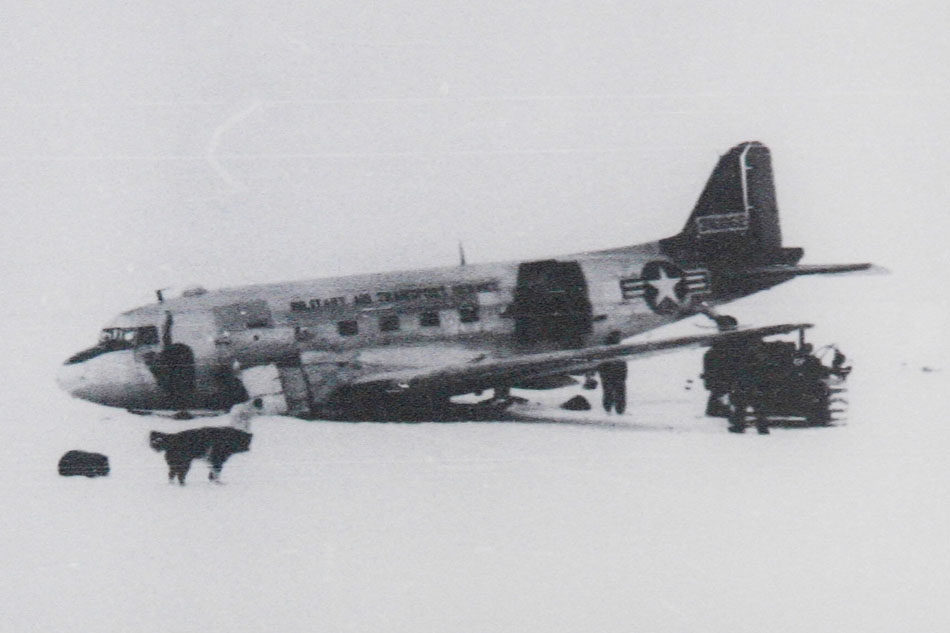
La aeronave ha sido identificado positivamente como Douglas C-47A Skytrain 43 a 16.062, fabricante número de serie 20528. Fue entregado a la USAF, el 14 de junio de 1944, y voló con el comando del portador de la tropa durante los años de guerra. Se estaba cumpliendo con el Servicio Militar de Transporte Aéreo (MATS) cuando se estrelló, y en ese momento era sólo un poco más de cinco años de edad y había registrado tan sólo 3.353 horas de vuelo.
En resumen, la C-47 se había estacionado en la pista toda la noche, tiempo durante el cual un poco de hielo se había acumulado en las alas. Pero el capitán no cree que sea necesario descongelar las alas, y sólo el parabrisas se limpió con alcohol. Para empeorar las cosas, el avión estaba sobrecargado, hubo un ligero viento cruzado, y la pista de aterrizaje estaba cubierto de cinco centímetros de nieve. Estos factores dieron como resultado un rendimiento de despegue muy pobre, y el avión simplemente no lograron despegar correctamente. Se ponía algo en el aire dos veces, pero no ganó suficiente altura. Los esquís y ruedas golpean un río poco profundo y se doblaron, y el ala derecha de cruce y de alcanzar el suelo (los daños causados por esto es evidente en la foto de Merlin). El avión cayó sobre los restos de sus esquís y se deslizó por la llanura cubierta de nieve durante una distancia considerable antes de llegar a una parada. Todos los pasajeros y la tripulación lograron escapar rápidamente, y nadie resultó herido de gravedad.
El daño a la aeronave fue significativa: dos puntales y dos enfriadores de aceite arrancado los motores, la izquierda y el tren de aterrizaje principal derecho obligado de nuevo a través de las góndolas de motor y ambos apoyos del puntal del tren de aterrizaje empujado hacia arriba a través de las alas, derecha ski rasgado por la mitad, esquí izquierdo severamente dañado, con el lado izquierdo del fuselaje desgarrado por la hélice izquierda justo detrás del asiento del piloto, ambos soportes de motor izquierdo y derecho roto en varios lugares, de la derecha dañada, el motor derecho # 12 culata roto y tirado por el lado del fuselaje, etc. Añadir a esto el hecho de que había varios miles de excedentes de aviones C-47 disponible en ese momento, todos los sobrantes de la Segunda Guerra Mundial, y está claro por qué la USAF consideró inmediatamente este avión una amortización total de -off y no intente ninguna reparación.
http://www.oldwings.nl/content/c47_yic/c47.htm

La aeronave ha sido identificado positivamente como Douglas C-47A Skytrain 43 a 16.062, fabricante número de serie 20528. Fue entregado a la USAF, el 14 de junio de 1944, y voló con el comando del portador de la tropa durante los años de guerra. Se estaba cumpliendo con el Servicio Militar de Transporte Aéreo (MATS) cuando se estrelló, y en ese momento era sólo un poco más de cinco años de edad y había registrado tan sólo 3.353 horas de vuelo.
En resumen, la C-47 se había estacionado en la pista toda la noche, tiempo durante el cual un poco de hielo se había acumulado en las alas. Pero el capitán no cree que sea necesario descongelar las alas, y sólo el parabrisas se limpió con alcohol. Para empeorar las cosas, el avión estaba sobrecargado, hubo un ligero viento cruzado, y la pista de aterrizaje estaba cubierto de cinco centímetros de nieve. Estos factores dieron como resultado un rendimiento de despegue muy pobre, y el avión simplemente no lograron despegar correctamente. Se ponía algo en el aire dos veces, pero no ganó suficiente altura. Los esquís y ruedas golpean un río poco profundo y se doblaron, y el ala derecha de cruce y de alcanzar el suelo (los daños causados por esto es evidente en la foto de Merlin). El avión cayó sobre los restos de sus esquís y se deslizó por la llanura cubierta de nieve durante una distancia considerable antes de llegar a una parada. Todos los pasajeros y la tripulación lograron escapar rápidamente, y nadie resultó herido de gravedad.
El daño a la aeronave fue significativa: dos puntales y dos enfriadores de aceite arrancado los motores, la izquierda y el tren de aterrizaje principal derecho obligado de nuevo a través de las góndolas de motor y ambos apoyos del puntal del tren de aterrizaje empujado hacia arriba a través de las alas, derecha ski rasgado por la mitad, esquí izquierdo severamente dañado, con el lado izquierdo del fuselaje desgarrado por la hélice izquierda justo detrás del asiento del piloto, ambos soportes de motor izquierdo y derecho roto en varios lugares, de la derecha dañada, el motor derecho # 12 culata roto y tirado por el lado del fuselaje, etc. Añadir a esto el hecho de que había varios miles de excedentes de aviones C-47 disponible en ese momento, todos los sobrantes de la Segunda Guerra Mundial, y está claro por qué la USAF consideró inmediatamente este avión una amortización total de -off y no intente ninguna reparación.
http://www.oldwings.nl/content/c47_yic/c47.htm
Última edición:

Algo de info de este aparato: https://normandyddayblog.wordpress.com/tag/dakota-aeroplane/
El día D, dos Dakotas se estrellaron en el área de Merville.
El primero fue el KG 426 de 48 de Royal Air Force de la escuadrilla. Tiraba de un planeador Horsa en Operación SILVESTRE, una misión de reabastecimiento hacia las zonas de noviembre y whisky en la zona Ranville-Benouville.
Su tripulación compuesta por:
F / S J Le Huray - Piloto
F / O HA Farrel - Co-piloto
F / S JM Woodcock - Navigator
Sgt R Carr - operador de radio.
El Dakota desengancho su planeador a 2107 horas y dos minutos más tarde fue alcanzado por el fuego antiaéreo en el motor de estribor. El avión comenzó a perder altura y el piloto ordenó F / S Woodcock y el sargento Carr para saltar (?).
Ambos aterrizaron cerca del río Orne, donde el sargento Carr se ahogó antes de poder prestarle asistencia.
El piloto y el copiloto aterrizaron con éxito el avión en un campo al oeste de Merville. Dieron cuenta de los restos y se escondieron en una casa cercana. Ellos fueron sacudidos pero no heridos.
El 12 de junio de 1944, el cuerpo del sargento Carr se encontró en la tierra pantanosa en la desembocadura del río Orne. Fue enterrado en el lugar. Su cuerpo fue exhumado el 2 de agosto de 1945, y trasladado al cementerio de la guerra Banneville.
JU-87 sumergido en las costas de Croacia.

Sigan el enlace, el video es imperdible:http://www.dailymail.co.uk/news/art...tom-Baltic-Sea-remarkably-good-condition.html

Sigan el enlace, el video es imperdible:http://www.dailymail.co.uk/news/art...tom-Baltic-Sea-remarkably-good-condition.html
Última edición:
M
Me 109
Temas similares
- Respuestas
- 251
- Visitas
- 99K
- Respuestas
- 7
- Visitas
- 2K
- Respuestas
- 27
- Visitas
- 4K
- Respuestas
- 133
- Visitas
- 34K







